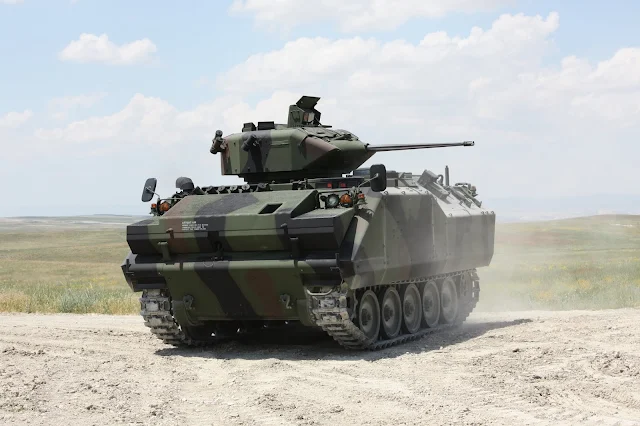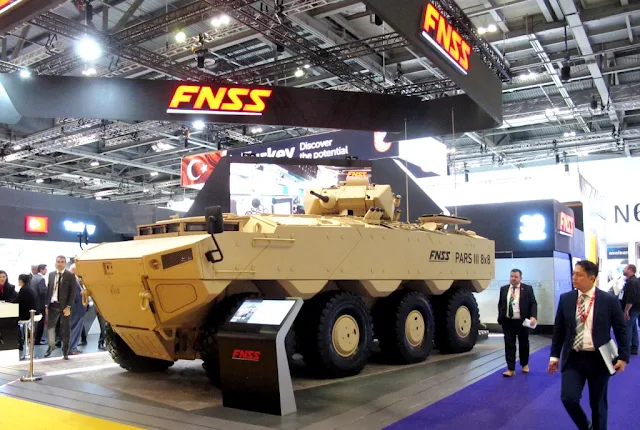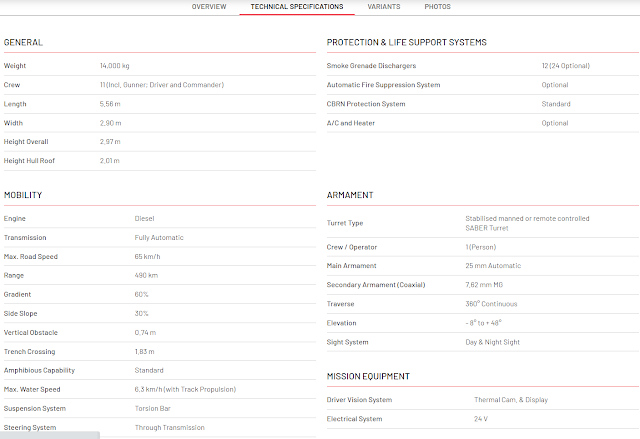The Philippine Army, in recent history, upgrades its inventory of M-113s with new automated gun turrets and remote controlled weapons systems, along with developments that involve new Sabrah Tanks delivered in the country in its first batches as both platforms signify a lot of recent improvements within the service branch's armored vehicles.
The roster of newly upgraded and newly purchased military vehicles operated by the Army is now getting added by these existing infantry fighting vehicles, which recently received its new set of capability upgrades of its own.
IN THE NEWS
 |
| Turkish FNSS's ACV-300 Infantry Fighting Vehicle. Image Source. |
The Philippine Army, along with the rest of the Armed Forces of the Philippines, continues to purchase brand new military hardware and upgrade existing ones as part of the ongoing implementation of the AFP Modernization Program, with the recent one coming as an upgrade of several of its own infantry fighting vehicles in service, now more capable and potent as it used to be.
Just recently, the Philippine Army's Armor "Pambato" Division presented thirteen (13) newly modernized vehicles, seven of which being the GKN Simba wheeled Infantry Fighting Vehicles now having its new engines, and the remaining units being the ACV-300 Infantry Fighting Vehicle (image seen above) with its new turrets carried out as part of an upgrade project coming alongside Elbit-armed M-113 Armored Personnel Carriers.
The Turkish defense company FNSS, the same company that produced these Infantry Fighting Vehicles to the Philippine Army, made the upgrades for the ACV-300s as part of the continuing bilateral defense cooperation between the Philippines and Turkey, as the latter has provide military hardware other than the ACV-300 Infantry Fighting Vehicles to the former such as the Philippine Air Force's T-129 'ATAK' Attack Helicopter, with the final batch of deliveries about to take place by the year 2024 or earlier.
Regarding the upgrades that the ACV-300 Infantry Fighting Vehicles received, the weapons turret installed onboard came as the Saber-40 and Saber-12.7 single-manned turrets, in which these are different in setup and operational management as opposed to Elbit's fully automated UT-25 unmanned turrets found onboard the M-113s upgraded by the Israeli firm.
With the news about the ACV-300 Infantry Fighting Vehicles released, let us cover the details surrounding the Turkish company that made these armored assets to the Philippine Army, along with the design of the platforms and eventually the single-manned turret upgrades these vehicles received from the said same Turkish defense firm.
KNOWING TURKEY'S FNSS
 |
| FNSS's PARS III, as displayed in Defense and Security Equipment International (DSEI) 2019. Image Source. |
The Turkish Defense Company FNSS, specifically known as FNSS Savunma Sistemleri A.Ş. (FNSS) as described in this website, is "a globally recognized joint venture land defence systems company owned by Nurol Holding (51%) and BAE Systems (49%)", basically a business venture pushed by the majority stakeholder in setting up a defense company in Turkey, while ensuring local production of military hardware and getting them sold in the Turkish Armed Forces and eventually, to several overseas customers.
The majority stakeholder, Nurol Holding, started in 1966 primarily as a construction and contracting works, and since then expanded to multiple business industries such as energy, mining, tourism, finance, and service sectors, as well as defense industry that is now embodied in FNSS's shape and form, with its primary specialty in designing and producing wheeled and tracked armored vehicles of different shapes and sizes, unmanned autonomous vehicles, gun turrets for those armored vehicles they produce, and sustainability solutions related to their products.
This is also the same company that jointly cooperated with Indonesia's PT Pindad in developing and eventually producing a Modern Medium-Weight Tank for Indonesian Armed Forces, known by many as the Kaplan MT or in Indonesian, the Harimau Hitam tank, whereby it competed to South Korean Defense firm Hanwha System's K-21 Medium Tank offer and the winning bid of Israeli Defense firm Elbit's Sabrah Light Tank offer, in which the joint Turkish-Indonesian firm lost to regarding their offer to the Philippine Army's Light Tank Acquisition Project.
Founded in 1988 as the FMC Nurol Savunma Sanayii A.Ş. or abbreviated as FNSS as it stands today, they started production of indigenously made armored vehicles intended to the Turkish Armed Forces, whereby the overall production started in the 1990s and since then continuously develop and produce their own products distinctly different from its licensed designs such as the ACV-300 Infantry Fighting Vehicles, showing that they improved overall as an outright Turkish defense company.
While their Kaplan MT/Harimau Hitam offer through an Indonesian joint venture failed to win the contract for the Philippine Army's Light Tank Acquisition Project, the Turkish defense firm has still successfully provide services to the military organization, especially in upgrading their own licensed products with modern turret technology that significantly improves its overall firepower capability as an Infantry Fighting Vehicle.
ACV-300 DESIGN ORIGINS
 |
| Philippine Army's AIFVs or Armored Infantry Fighting Vehicles. (c) Wikimedia Commons. |
While the ACV-300 Infantry Fighting Vehicles of the Philippine Army originate from Turkey's FNSS, the design itself is not exactly indigenous to the Turkish and instead a clear derivative to the Armored Infantry Fighting Vehicle or AIFV from the FMC Corporation, which is not surprising since it is their partnership with Nurol Holding in 1988 that the Turkish defense company FNSS has founded.
The Philippine Army actually has a handful of AIFVs in its inventory, with the first ones delivered in the 1975, totalling 51 units of that type and since then served the Philippine Army's Armor Division alongside other armored vehicles like the M-113s, GKN Simba, and FV101 Scorpion Light Tank, even before the licensed copies and eventual mass production of what will become the ACV-300s became a thing in Turkey, supplanting a portion of its armored vehicle needs.
Regarding the design of the Armored Infantry Fighting Vehicle or AIFV, the FMC Corporation took the inspiration of producing these vehicles from another armored platform they made which is the M-113 Armored Personnel Carrier, whereby it is currently in-service among several armies across the world, including the Philippine Army wherein several of those platforms received firepower capability upgrades from Israel's Elbit Systems Ltd.
FMC Corporation developed on what should be the successor for the M-113 in the United States Army as they offered it for the Mechanized Infantry Combat Vehicle or MICV-65 program as the FMC's prototype for XM701 MICV, although they still developed it further despite the United States not adopting the platform, until it became what is now known as the XM765 AIFV, coming with multiple variants, including the ones produced by Turkey's FNSS.
Now, even though the original developer and manufacturer of the armored vehicles now focuses more on food production and technologies development and are long gone from the field of defense, their armored personnel carrier and infantry fighting vehicle products still serve great purpose to the armed forces that still have them currently, as it used in several counterinsurgency operations through the years as for the Philippine Army's case.
FNSS' SABER SINGLE-MANNED TURRET
 |
| Saber-25mm one-manned turret made by the FNSS. The Philippine Army have the 12.7mm and 40mm ones. Image Source. |
The primary upgrade introduced to the six (6) ACV-300s that the Philippine Army currently has in its inventory is the installation of FNSS's new Saber single-manned turrets, specifically the 40mm and 12.7mm version of those turrets, as these upgrades came with its own type of sophistication, as these are manned platforms as opposed to the Elbit-installed UT-25 Remote-Controlled Weapons System platforms onboard.
Although different variants of the Saber single-manned turret have mentioned here, the primary underlying systems structure stayed the same, especially the fire control system onboard that has automatic ballistic computing feature onboard along with a standard thermal imager with the specifications of 8-12 micrometers or 3-5 micrometers and a laser range finder of 8,000 meters (8 kilometers) range.
Development of the SABER turret weapon system started in 2013 through its private funding by FNSS, and since then the Turkish defense company with their expertise in weapons systems as incurred in 15 years of their experience, incorporated the latest technologies as mentioned especially with its sensory systems and its sophisticated fire control system, really enabling a single-manned turret platform to get its job done, aiding the gunner in aiming and eliminating a target in the mission.
As we specify in-detail the turrets that the Philippine Army receives for its ACV-300 upgrade, the main armament comes with a 40mm automatic grenade launcher and a 12.7mm machine gun, coming different from the Oerlikon KBA-B02 25mm turret installed onboard the Philippine Army's other Armored Infantry Fighting Vehicles (AIFV), in a similar configuration with the likes of the Dutch YPR-765 AIFV platforms.
Continuing to the specifications provided by FNSS in their website, the overall turret weight of a Saber one-manned turret comes at around 1,800kg following the combat weight with SABER-25 Configuration, while the Ring Gear Diameter of the turret comes at around 1,000mm, a Swing Radius of 2,600mm, and also the dimensions of the turrets at around 1.6meter width and 0.61m height, above mounting surface.
PLATFORM SPECIFICATIONS
 |
| ACV-300 specifications, as stated the FNSS website. Kindly click the image to enlarge. Image Source. |
The ACV-300 Infantry Fighting Vehicle, true to its origins to the M-113 Armored Personnel Carrier as designed by the same defense manufacturer, always comes with the same weight of around 14 tons or 14,000 kilograms, while it has the capacity of carrying 11 total personnel onboard, with three being the very crew of the armored vehicle (gunner, driver, and commander), while the rest are troop passengers onboard.
The dimensions come as approximately near and equal with those for the M-113s, whereby the length of the ACV-300 Infantry Fighting Vehicle comes at around 5.56m as opposed to the M-113's shorter 5.3 meters, whilst the width of the ACV-300 comes narrower at around 2.90 meters comparing to the wider 3 meters of the M-113 Armored Personnel Carriers.
Regarding its performance on mobility, the ACV-300 Infantry Fighting Vehicle comes with a maximum road speed of 65 kilometers per hour and a maximum travel range of 490 kilometers, almost similar in speed with the M-113 Armored Personnel Carrier's 66 kilometers per hour, although the latter lacks the maximum travel range, only limited to around 483 kilometers maximum or 7 kilometers short.
Other features include a similar gradient of around 60% on both the ACV-300s and M-113 armored vehicles, and a similar side slope for both platforms at around 30%, although the weapons configuration of both platforms vary as the former now carries the one-manned turret systems that FNSS provided to the Philippine Army, while the latter comes with remote-controlled weapons systems and mortar carriers, as provided by Elbit Systems Ltd.
It is nice to take note that the near similarities of both the ACV-300 and M-113 platforms, especially given that it came from the same developer of the armored vehicles, give the Philippine Army the edge especially with regards to handling the logistics not only regarding with the spare parts and maintenance procedures, but also regarding to its overall operational use, especially now that the said armored vehicles comes with varying weapons configuration from different weapons suppliers.
TO SURMISE THIS UP
 |
| Philippine Army, as unveiled their newly upgraded armor assets. Image Source. |
Philippine Army's Armor "Pambato" Division recently received these newly upgraded land assets, coming as the ACV-300 Infantry Fighting Vehicles that are armed by Saber turrets from FNSS, adding it up to the roster of recent military hardware upgrades and military asset acquisition projects made by the service branch since the AFP Modernization Program under R.A. 10349 has started.
The upgraded ACV-300 Infantry Fighting Vehicles that the Philippine Army has during the ceremony also comes with 7 units of GKN Simba APCs coming with new engines, although the organization has expressed plans in eventually replacing these platforms along with V-150 Cadillac Gage Commando Armored Personnel Carriers in the long run once the newer Brazilian-made IVECO VBTP-MR Guarani 6x6 Armored Personnel Carriers.
This shows the constant bilateral cooperation between the Philippines and Turkey, as the latter recently provides the former with its military hardware like the T-129 ‘ATAK’ Attack Helicopter, whereas the former now has the chance to help the latter in dealing with the current calamity that took place in Southern Turkey when there was a 7.8 earthquake that happened during the month this article has written which is apparently the deadliest one to-date. (taps to the fallen).
The developments may not end here, as the Philippine Army may receive more military hardware for the years to come, especially with its desired plans to have more Medium Main Battle Tanks or MMBTs that may augment the current Sabrah ASCOD and Pandur-platformed tanks, as other nations have the desire to provide the Philippines such additional military hardware later on, with discussions about it taking place here soon.
To surmise this up, the Philippine Army has continuously improved its military hardware, especially the ones operated by the Armor “Pambato” Division, and it there is an expectation that more armored vehicles may enter service with these units years from now as the Horizon 3 of the Revised AFP Modernization Program is rolling, along with other developments that may surely give that significant firepower and numerical boost that the organization needs in achieving its modernization aim with more interesting topics coming on its way across defense circles later on.













No comments:
Post a Comment